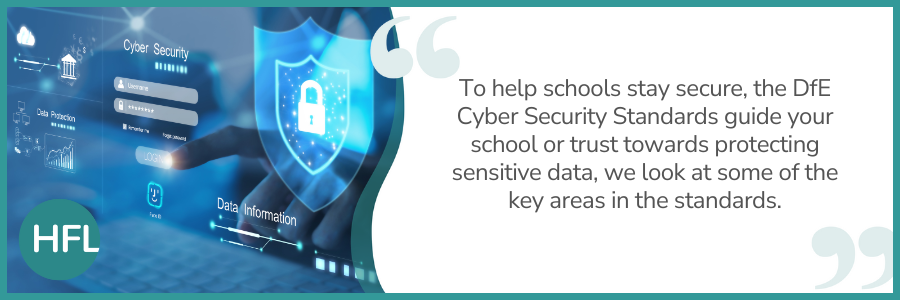
The UK Government’s Cyber Security Breaches Survey 2025 found that 60% of secondary schools and 44% of primaries reported an incident in the past year alone. In today’s digital world, schools and trusts are prime targets for cyber-attacks. From phishing emails to ransomware, educational settings are dealing with a growing number of cyber threats. With schools handling large amounts of sensitive data, such as student records and staff information, a breach can be disastrous. It can lead to financial loss, damage to a school or trust’s reputation, and interruptions to teaching and learning. In fact, the education sector is now one of the most targeted industries for cyber-attacks in the UK.
Due to this, the Department for Education (DfE) has introduced Cyber security standards for schools and colleges. Embedded into the overall Digital Standards for Schools and Colleges, these guidelines provide a cyber security framework designed to prevent data breaches and keep school systems safe and secure.
What are the DfE Cyber Security Standards?
To help schools stay secure, the DfE Cyber Security Standards guide your school or trust towards protecting sensitive data, meeting legal requirements, and reducing the risk of cyber-attacks. Here’s a quick look at some of the key areas in these standards:
- Governance: It’s important that schools have leaders in place to oversee cybersecurity. This includes regular policy reviews and risk assessments to stay on top of any potential threats.
- Security controls: Schools should have basic security measures like firewalls, strong passwords, and antivirus software to keep hackers out.
- Incident management: Schools need to be prepared in case something goes wrong. A good incident response plan will help you react quickly to minimise damage from a breach or cyber-attack.
- Data protection: Protecting student and staff data is a top priority. Schools must have strict rules in place to control who can access this information.
- Patching and updates: Keeping your software up to date is crucial. Regular patches and updates fix known vulnerabilities and help prevent attacks.
Following these standards is vital for schools and trusts to stay secure and keep their systems running smoothly.
How can schools and trusts protect themselves?
Meeting the DfE cybersecurity standards is a key step in protecting your school or trust, but where do you start? Here are some practical tips and solutions to help you keep cyber threats at bay:
- Firewalls and antivirus software: Installing a reliable firewall and antivirus solution is a must. A firewall helps monitor traffic and block suspicious activity, while antivirus software scans for and removes harmful programs like malware. In some cases, your broadband provider may be managing your firewall for you – if you are subscribed to our HFL Broadband service for example - then you will already be protected by a central firewall.
- Data encryption: Encrypting sensitive data ensures that even if it gets intercepted, it can’t be read by anyone without the proper access. This is especially important for personal data like student records. This can include using tools such as BitLocker (Windows) to protect physical hard drives, or cloud storage encryption if you hold your school data online. Most cloud providers like Google and Microsoft do offer encryption services for data stored in their systems, but it’s worth checking this for any other systems you use which hold your school data – i.e. your school Management Information System (MIS).
- Multi-Factor Authentication (MFA): MFA adds an extra layer of security by requiring more than just a password. For schools, MFA could be set up in various ways. Typically, a user would log in with their password and then complete a second verification step. This second factor could be:
- A code sent to a mobile device (via SMS or an authentication app like Google Authenticator or Microsoft Authenticator).
- A physical security key (like a USB device) that needs to be plugged into the computer to verify the user’s identity.
- Staff training: Human error remains one of the biggest risks to cybersecurity in schools. Even with the best technical protections in place, staff and students need to be aware of the tactics cyber criminals use to target schools - like phishing emails, fake links, and social engineering. The National Cyber Security Centre (NCSC) offers a free training video specifically designed for school staff, covering the most common threats and how to handle them.
- Backup and recovery solutions: Make sure you have regular backups of your data – this should include both on-site AND cloud data. If a ransomware attack hits, having a backup means you won’t lose important information. Plus, it helps you get back up and running quickly. When it comes to backup and recovery solutions for schools, HFL offer a range of products and services to suit the needs of your school or trust. Please reach out if you would like to know more about these solutions and which is the best fit for your needs and setting.
- Incident response plan: Schools and trusts should have a plan in place for dealing with cyber-attacks. Knowing what to do in the event of a breach can make all the difference in how quickly and effectively you recover.
By putting these tools and strategies in place, schools and trusts can significantly reduce the risk of falling victim to a cyber-attack or data breach.
Conclusion
With the rise of cyber-attacks and data breaches in the UK, schools and trusts need to take cybersecurity seriously. The DfE cyber security standards provide essential guidance to help protect your school or trusts data and systems. By following these guidelines and implementing strong security measures, schools and trusts can keep their students and staff safe while minimising the impact of any potential attack.
To learn more about how your school or trust can improve its cybersecurity, check out our dedicated Technology in Schools page, for expert advice and solutions tailored to the education sector.
Cybersecurity is no longer just a concern for IT departments — it’s a core leadership responsibility. From safeguarding sensitive data to ensuring compliance and maintaining the trust of families, protecting your school’s digital environment is essential.
For school leaders, this added responsibility can feel overwhelming. You're already managing curriculum priorities, tight budgets, and staff wellbeing — and now cyber resilience is part of your remit. The good news? You don’t need to be a technical expert to lead effectively in this space.
What matters most is your mindset and approach: asking the right questions, setting clear expectations, and modelling safe digital behaviours. By doing so, you help create a culture of security that protects students, staff, and the wider school community.
Next steps
To support schools further, we now offer ongoing cybersecurity support packages — tailored to meet the unique challenges of educational environments. Whether you're looking to improve your current setup or build a more resilient digital foundation, we’re here to help.
Developed in line with guidance from the Department for Education (DfE) and the National Cyber Security Centre (NCSC), our cybersecurity audit service is designed to support both leadership teams and IT staff. It helps identify vulnerabilities, embed best practices, and ensure compliance with evolving expectations across the education sector.
To learn more about how your school or trust can improve its cybersecurity or register interest in our audit service and support options, please connect with me directly via my email address below.
This blog was originally published 30/10/2024.

